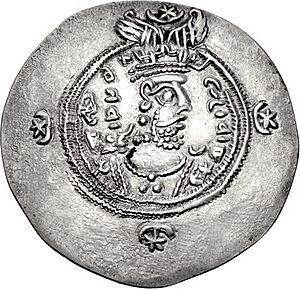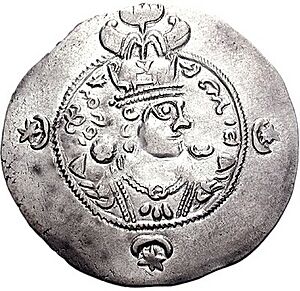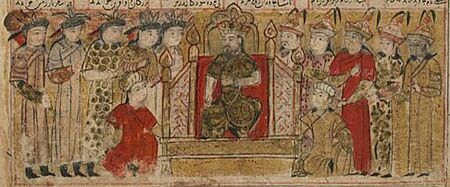Yazdegerd III facts for kids
Quick facts for kids Yazdegerd III𐭩𐭦𐭣𐭪𐭥𐭲𐭩 |
|
|---|---|
| King of Kings of Iran and non-Iran | |

Drachma of Yazdegerd III, minted in Sakastan in 651
|
|
| Shahanshah of the Sasanian Empire | |
| Reign | 16 June 632 – 651 |
| Coronation | Istakhr |
| Predecessor | Boran |
| Successor | Office abolished |
| Born | 624 Istakhr |
| Died | 651 (aged 27) Marw |
| Issue | Peroz III Bahram VII Shahrbanu (alleged) Izdundad |
| House | House of Sasan |
| Father | Shahriyar |
| Religion | Zoroastrianism |
Yazdegerd III (Middle Persian: 𐭩𐭦𐭣𐭪𐭥𐭲𐭩) was the very last king of the Sasanian Empire in Iran. He ruled from 632 to 651. His father was Shahriyar, and his grandfather was Khosrow II.
Yazdegerd became king when he was only eight years old. Because he was so young, he didn't have much real power. Instead, army leaders and powerful nobles were in charge. They often fought among themselves. These fights made the Sasanian Empire weak. Enemies like the Göktürks from the east and Khazars from the west started to invade. Yazdegerd couldn't stop the Muslim Arabs from conquering Iran. He spent most of his time as king running from place to place. He hoped to gather an army, but it was very difficult. Yazdegerd died near Merv in 651. His death ended the last pre-Islamic Iranian empire after more than 400 years.
Contents
What's in a Name?
The name Yazdegerd means "God-made." It comes from Old Iranian words. It's similar to the Greek name Theoktistos. His name was known in many languages. For example, in Middle Persian it was Yazdekert. In Arabic, it was Yazdeijerd.
The Empire Before Yazdegerd
Yazdegerd was the son of Prince Shahriyar. His grandfather was Khosrow II, a very important king. In 628, Khosrow II was overthrown and killed by his own son, Kavad II. Kavad II then had all his brothers killed, including Shahriyar. This event greatly hurt the empire. It never fully recovered.
After Khosrow II's fall, a civil war began. It lasted for four years. Powerful nobles started to rule their own areas. There were also old fights between Persian and Parthian noble families. This split the country's wealth. A few months later, a terrible plague hit. It killed half the people in the western parts of the empire. Kavad II also died from this plague.
Kavad II's eight-year-old son, Ardashir III, became king. But he was killed two years later by a general named Shahrbaraz. Shahrbaraz was then killed after only forty days. Many rulers came and went after that. Finally, Boran, a daughter of Khosrow II, became queen again in 631. But she was killed the next year.
The most powerful nobles, Rostam Farrokhzad and Piruz Khosrow, decided to work together. They put Yazdegerd III on the throne. This finally ended the civil war. Yazdegerd was crowned in Istakhr. This was the same place where the first Sasanian king, Ardashir I, had been crowned. People hoped Yazdegerd would bring new life to the empire. He was almost the last living member of the House of Sasan. Most experts believe Yazdegerd was eight years old when he became king.
Yazdegerd's Reign
Challenges Facing the Empire
Yazdegerd did not have the power to make his large empire stable. It was quickly falling apart. Army commanders, courtiers, and nobles fought constantly. Many governors in the empire declared themselves independent. They created their own small kingdoms.
For example, the governors of Mazun and Yemen became independent during the civil war. This meant the Sasanians lost control of the Arabian peninsula. That area was now uniting under the new religion of Islam. Some historians believe the Sasanians had already lost much land after Khosrow II's death in 628.
The empire started to look like the old Parthian system. Yazdegerd was seen as the rightful king. But he didn't control all of his empire. In his early years, coins were only made in certain southern regions. These were areas where the Persian nobles were strong. The Parthian nobles in the north refused to make coins with his image. Even in the south, Yazdegerd's rule wasn't completely safe. Another Sasanian who claimed the throne, Khosrow IV, made his own coins in Susa until 636. Some experts think Yazdegerd didn't even control the capital city, Ctesiphon.
At the same time, the empire was attacked from all sides. The Göktürks invaded from the east. The Khazars attacked from the west, raiding Armenia. The Sasanian army was very weak. This was due to a long war with the Byzantines and internal fighting. The situation was so bad that people openly spoke of the empire's end. They saw bad signs in natural disasters.
Early Fights with Muslim Arabs

In May 633, Muslim forces defeated a Sasanian army. This happened near the important city of Hira, which was soon taken. After Hira fell, Yazdegerd paid more attention to the Muslims. Rostam Farrokhzad sent an army against them. This army was led by Persian and Armenian officers. The Sasanian army managed to defeat the Muslims at the Battle of the Bridge.
In 636, Yazdegerd III ordered Rostam Farrokhzad to defeat the invading Arabs. He told Rostam, "Today you are the most important man among the Iranians." He also said that Iran had not faced such a situation since the first Sasanian king, Ardashir I. Some people then asked Yazdegerd to remove Rostam. They wanted someone else to lead the people.
Yazdegerd III asked Rostam what he thought of the Arab forces. Rostam said the Arabs were "a pack of wolves." He said they were attacking "unsuspecting shepherds." Yazdegerd III replied, comparing the Arabs and Persians to an eagle and birds. He said the eagle would pick off any bird that left the group.
The Last Stand
The Sasanian army suffered a huge defeat at the Battle of al-Qadisiyyah. Many important generals were killed in this battle. The Arabs then marched towards the Sasanian capital, Ctesiphon, without much resistance. Yazdegerd took his treasures and fled to Hulwan. He left Rostam Farrokhzad's brother, Farrukhzad, in charge of Ctesiphon. But Farrukhzad also left for Hulwan.
The Arabs then reached Ctesiphon and took over the city. The defeat at Qadisiyyah is often called a turning point. But it was more of a wake-up call for the Iranian armies. They realized that their constant fighting could destroy them. After Ctesiphon fell, people started to encourage each other. They said, "If you scatter now, you will never get together again."
In April 637, the Arabs defeated another Sasanian army at the Battle of Jalula. After this loss, Yazdegerd fled deeper into Media. He then gathered a new army. He sent it to Nahavand to try and take back Ctesiphon. He also wanted to stop the Arabs from advancing further. This new army seemed like a serious threat. The Arab leader, Umar, combined his forces. He sent them against the Sasanians.
The battle at Nahavand in 642 lasted several days. Both sides had heavy losses. This was the second major military disaster for the Sasanians.
Yazdegerd's Flight
After the disaster at Nahavand, Yazdegerd fled to Isfahan. He gathered a small army there. But this army turned against him. They agreed to help the Arabs in return for land. Meanwhile, Yazdegerd arrived in Estakhr. He tried to organize a resistance there. However, in 650, an Arab governor invaded Estakhr. He ended the Persian resistance. Estakhr was destroyed, and many Persian nobles were killed.
After the Arabs conquered Pars, Yazdegerd fled to Kirman. An Arab force chased him. Yazdegerd managed to escape them in a snowstorm. When he reached Kirman, he argued with the local governor. So he left Kirman for Sakastan. Another Arab army arrived and killed the governor of Kirman.
When Yazdegerd arrived in Sakastan, he lost the governor's support. This was because he demanded taxes from him. Yazdegerd then headed for Merv. He wanted to join the leader of the Turks. But when he reached Khorasan, the people there disagreed with his plan to keep fighting. They told him to make peace with the Arabs. Yazdegerd refused. Sakastan was later taken by Arab forces around 650–652.
Yazdegerd also received help from the Principality of Chaghaniyan. They sent him troops to fight the Arabs. When Yazdegerd arrived in Marw, he demanded taxes from the local governor. This made the governor lose his support. The governor then allied with Nezak Tarkan, a Hephthalite ruler. They defeated Yazdegerd and his followers.
Help from China

As Yazdegerd III faced attacks from the Muslim Arabs, he sent a messenger to China in 639. He offered gifts to the Chinese emperor. As he kept losing battles, he sent more messengers in 647 and 648. He asked for help from China to form a new army.
Some help arrived only in 661. This was after Yazdegerd's son, Peroz III, sent more messengers. The Chinese set up a "Persian military command" in Tokharistan. Peroz was made the military commander. In 679, a Chinese army went with Narsieh, Peroz's exiled son. They aimed to put him back on the Sasanian throne. But the army stopped in Tokharistan. They fought against the Western Turkic Khaganate instead. Narsieh was left to fight the Muslim Arabs for the next twenty years.
Death and Legacy
After his defeat, Yazdegerd found safety with a miller near Marw. However, the miller murdered him in 651. Some say the miller killed Yazdegerd for his jewelry. Others say the miller was sent by Mahoe Suri.
Yazdegerd's death marked the end of the Sasanian Empire. It made it easier for the Arabs to conquer the rest of Iran. All of Khorasan was soon taken by the Arabs. They used it as a base to attack other regions. Yazdegerd's death ended the last pre-Islamic Iranian empire after more than 400 years. This empire had once conquered Egypt and Asia Minor. It even reached Constantinople. But it fell to a force of lightly armed Arabs. The heavy Sasanian cavalry was too slow to stop them.
Christian monks reportedly buried Yazdegerd. They placed him in a tall tomb in a garden. A Christian bishop organized his funeral. This was because the king's grandmother was Christian. The monks cursed Mahoe, who was involved in the king's murder. They sang a hymn for Yazdegerd, mourning the fall of a "combative" king. This shows that Christians in the empire stayed loyal to the Sasanians. This was perhaps even more than some Iranian nobles.
Yazdegerd's wife was said to be Christian. His son, Peroz III, seemed to follow Christianity. He even built a church in Tang China, where he found safety. Yazdegerd became known as a martyred prince in history. Many later rulers claimed to be his descendants.
Yazdegerd was educated and cultured. But his pride and inability to understand the real situation caused problems. He often argued with his governors. His influence decreased as he fled from city to city. In each new place, he acted like a powerful king. But he was actually an outcast running from enemies. This, along with his military failures, turned many loyal people away from him.
Zoroastrian Calendar
The Zoroastrian religious calendar is still used today. It uses Yazdegerd III's first year as king as its starting point. Its year numbering system uses a Y.Z. suffix.
Some Zoroastrian priests believed Yazdegerd III's death was the end of one era. They saw it as the start of a new one.
See Also
- Death of Yazdgerd (film)
- Death of Yazdgerd (play)




